How To Find The Solution Of A Quadratic Equation
Quadratic Equations
85 Graphing Quadratic Equations
Learning Objectives
By the end of this section, you volition exist able to:
- Recognize the graph of a quadratic equation in two variables
- Find the axis of symmetry and vertex of a parabola
- Detect the intercepts of a parabola
- Graph quadratic equations in two variables
- Solve maximum and minimum applications
Recognize the Graph of a Quadratic Equation in Two Variables
We have graphed equations of the form ![]() . We called equations like this linear equations because their graphs are straight lines.
. We called equations like this linear equations because their graphs are straight lines.
Now, we will graph equations of the form ![]() . We telephone call this kind of equation a quadratic equation in ii variables.
. We telephone call this kind of equation a quadratic equation in ii variables.
Quadratic Equation in 2 Variables
A quadratic equation in two variables, where ![]() are real numbers and
are real numbers and ![]() , is an equation of the form
, is an equation of the form
![]()
Simply like we started graphing linear equations past plotting points, nosotros will do the same for quadratic equations.
Allow's expect kickoff at graphing the quadratic equation ![]() . We volition choose integer values of
. We volition choose integer values of ![]() between
between ![]() and 2 and find their
and 2 and find their ![]() values. See (Figure).
values. See (Figure).
| | |
| | |
| 0 | 0 |
| 1 | 1 |
| | 1 |
| 2 | 4 |
| | 4 |
Notice when nosotros permit ![]() and
and ![]() , we got the same value for
, we got the same value for ![]() .
.

The same matter happened when we permit ![]() and
and ![]() .
.
Now, nosotros will plot the points to show the graph of ![]() . Encounter (Figure).
. Encounter (Figure).
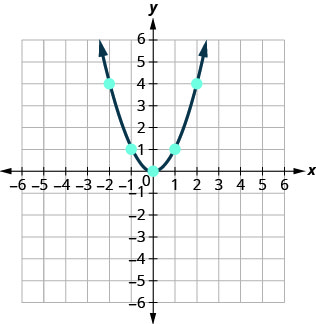
The graph is not a line. This effigy is called a parabola. Every quadratic equation has a graph that looks like this.
In (Figure) you lot volition practise graphing a parabola by plotting a few points.
Graph ![]() .
.
Solution
We will graph the equation by plotting points.
| Choose integers values for x, substitute them into the equation and solve for y. | ||
| Record the values of the ordered pairs in the chart. | 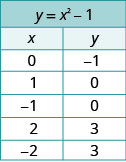 | |
| Plot the points, and so connect them with a smooth bend. The event will be the graph of the equation | 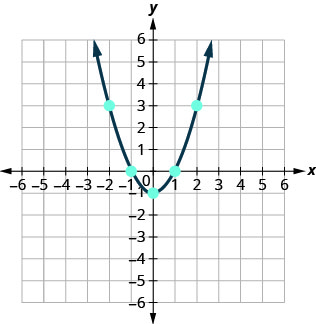 | |
Graph ![]() .
.
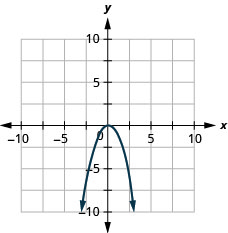
Graph ![]() .
.
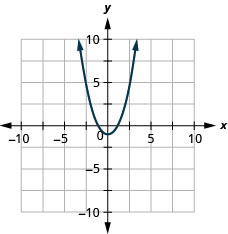
How do the equations ![]() and
and ![]() differ? What is the departure betwixt their graphs? How are their graphs the same?
differ? What is the departure betwixt their graphs? How are their graphs the same?
All parabolas of the form ![]() open upward or downwards. See (Figure).
open upward or downwards. See (Figure).
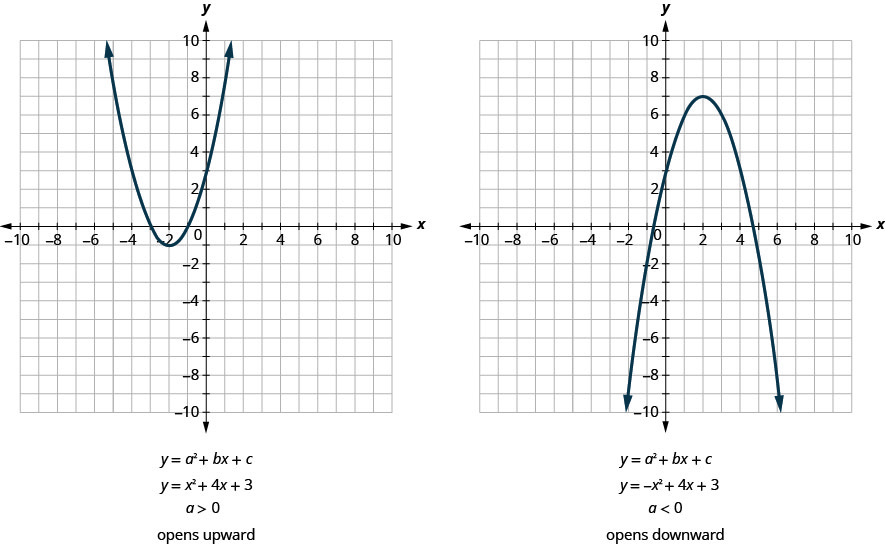
Observe that the only divergence in the ii equations is the negative sign before the ![]() in the equation of the 2nd graph in (Effigy). When the
in the equation of the 2nd graph in (Effigy). When the ![]() term is positive, the parabola opens upward, and when the
term is positive, the parabola opens upward, and when the ![]() term is negative, the parabola opens downward.
term is negative, the parabola opens downward.
Parabola Orientation
For the quadratic equation ![]() , if:
, if:

Decide whether each parabola opens upward or downwardly:
ⓐ ![]() ⓑ
ⓑ ![]()
Solution
| ⓐ Find the value of "a". |  Since the "a" is negative, the parabola will open downward. | |
| ⓑ Find the value of "a". |  Since the "a" is positive, the parabola will open upward. | |
Decide whether each parabola opens upwardly or downwardly:
ⓐ ![]() ⓑ
ⓑ ![]()
ⓐ upwardly ⓑ downward
Determine whether each parabola opens upward or downward:
ⓐ ![]() ⓑ
ⓑ ![]()
ⓐ down ⓑ up
Find the Centrality of Symmetry and Vertex of a Parabola
Wait again at (Figure). Practice you encounter that we could fold each parabola in half and that i side would lie on elevation of the other? The 'fold line' is a line of symmetry. We call information technology the axis of symmetry of the parabola.
We show the same 2 graphs again with the centrality of symmetry in ruddy. Run across (Effigy).
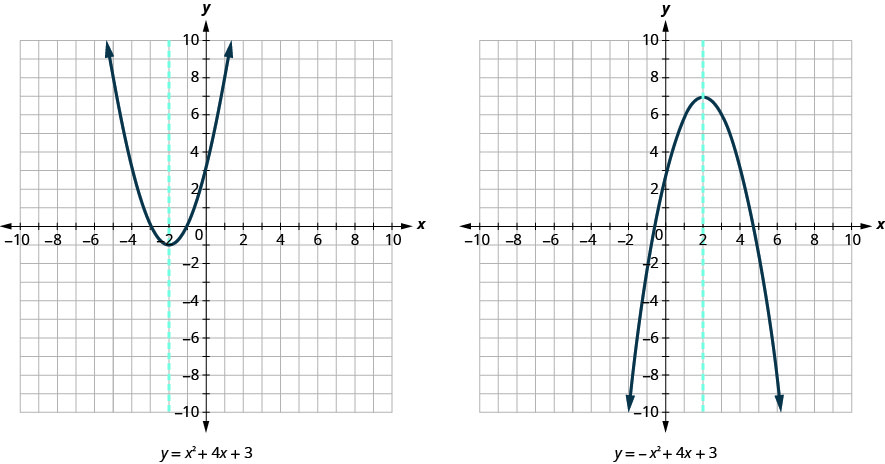
The equation of the axis of symmetry can be derived by using the Quadratic Formula. We will omit the derivation hither and proceed directly to using the result. The equation of the axis of symmetry of the graph of ![]() is
is ![]()
And so, to find the equation of symmetry of each of the parabolas nosotros graphed in a higher place, we volition substitute into the formula ![]() .
.
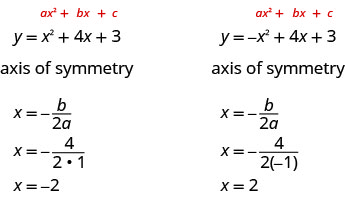
Look back at (Figure). Are these the equations of the dashed red lines?
The point on the parabola that is on the axis of symmetry is the lowest or highest bespeak on the parabola, depending on whether the parabola opens upward or down. This point is called the vertex of the parabola.
We can easily discover the coordinates of the vertex, because we know it is on the axis of symmetry. This ways its x-coordinate is ![]() . To find the y-coordinate of the vertex, we substitute the value of the x-coordinate into the quadratic equation.
. To find the y-coordinate of the vertex, we substitute the value of the x-coordinate into the quadratic equation.
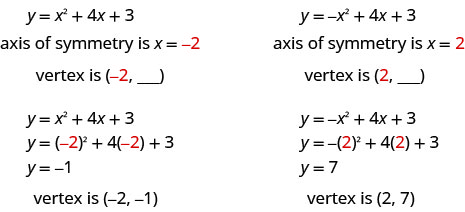
Centrality of Symmetry and Vertex of a Parabola
For a parabola with equation ![]() :
:
To find the y-coordinate of the vertex, we substitute ![]() into the quadratic equation.
into the quadratic equation.
For the parabola ![]() detect: ⓐ the axis of symmetry and ⓑ the vertex.
detect: ⓐ the axis of symmetry and ⓑ the vertex.
For the parabola ![]() observe: ⓐ the axis of symmetry and ⓑ the vertex.
observe: ⓐ the axis of symmetry and ⓑ the vertex.
ⓐ ![]() ⓑ
ⓑ ![]()
For the parabola ![]() find: ⓐ the centrality of symmetry and ⓑ the vertex.
find: ⓐ the centrality of symmetry and ⓑ the vertex.
ⓐ ![]() ⓑ
ⓑ ![]()
Detect the Intercepts of a Parabola
When we graphed linear equations, we oft used the x– and y-intercepts to assistance us graph the lines. Finding the coordinates of the intercepts volition help united states of america to graph parabolas, too.
Remember, at the y-intercept the value of ![]() is zero. And so, to find the y-intercept, nosotros substitute
is zero. And so, to find the y-intercept, nosotros substitute ![]() into the equation.
into the equation.
Let's observe the y-intercepts of the two parabolas shown in the figure below.
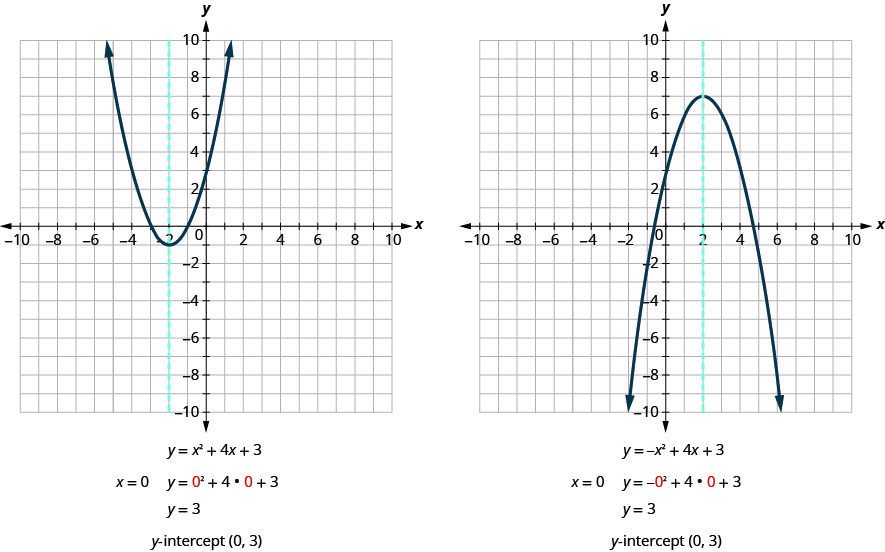
At an x-intercept, the value of ![]() is zero. To find an x-intercept, nosotros substitute
is zero. To find an x-intercept, nosotros substitute ![]() into the equation. In other words, we volition need to solve the equation
into the equation. In other words, we volition need to solve the equation ![]() for
for ![]() .
.
![]()
But solving quadratic equations like this is exactly what we have done earlier in this chapter.
We can now notice the x-intercepts of the two parabolas shown in (Effigy).
Outset, we will find the x-intercepts of a parabola with equation ![]() .
.
 | ||
| Let |  | |
| Factor. |  | |
| Use the cipher product property. |  | |
| Solve. |  | |
| The x intercepts are | ||
Now, we will discover the 10-intercepts of the parabola with equation ![]() .
.
 | ||
| Let |  | |
| This quadratic does not factor, so we use the Quadratic Formula. |  | |
| |  | |
| Simplify. |     | |
| The x intercepts are | ||
We will use the decimal approximations of the x-intercepts, so that we tin locate these points on the graph.
![]()
Do these results agree with our graphs? See (Figure).
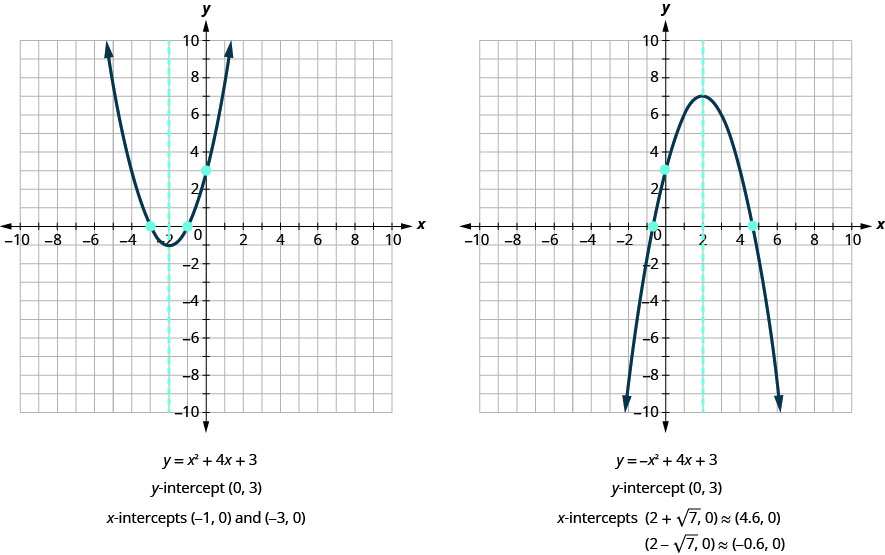
Find the intercepts of a parabola.
To find the intercepts of a parabola with equation ![]() :
:
![]()
Find the intercepts of the parabola ![]() .
.
Find the intercepts of the parabola ![]()
![]()
Detect the intercepts of the parabola ![]()
![]()
In this affiliate, we have been solving quadratic equations of the form ![]() . We solved for
. We solved for ![]() and the results were the solutions to the equation.
and the results were the solutions to the equation.
We are at present looking at quadratic equations in 2 variables of the grade ![]() . The graphs of these equations are parabolas. The ten-intercepts of the parabolas occur where
. The graphs of these equations are parabolas. The ten-intercepts of the parabolas occur where ![]() .
.
For example:

The solutions of the quadratic equation are the ![]() values of the 10-intercepts.
values of the 10-intercepts.
Earlier, nosotros saw that quadratic equations have 2, one, or 0 solutions. The graphs below bear witness examples of parabolas for these iii cases. Since the solutions of the equations requite the 10-intercepts of the graphs, the number of x-intercepts is the same as the number of solutions.
Previously, we used the discriminant to determine the number of solutions of a quadratic equation of the form ![]() . Now, we can use the discriminant to tell us how many x-intercepts in that location are on the graph.
. Now, we can use the discriminant to tell us how many x-intercepts in that location are on the graph.
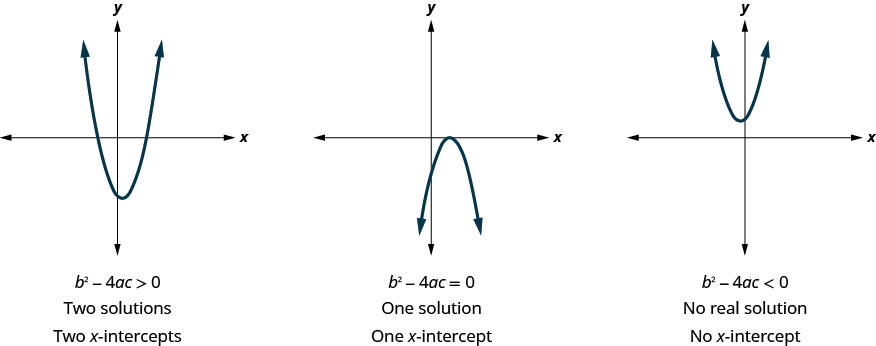
Earlier you start solving the quadratic equation to find the values of the ten-intercepts, y'all may want to evaluate the discriminant so you lot know how many solutions to look.
Notice the intercepts of the parabola ![]() .
.
Find the intercepts of the parabola ![]()
![]()
Discover the intercepts of the parabola ![]()
![]()
Find the intercepts of the parabola ![]() .
.
Observe the intercepts of the parabola ![]()
![]()
Find the intercepts of the parabola ![]()
![]()
Graph Quadratic Equations in Two Variables
Now, we have all the pieces nosotros demand in order to graph a quadratic equation in two variables. We just demand to put them together. In the next case, nosotros will see how to exercise this.
How To Graph a Quadratic Equation in Two Variables
Graph ![]() .
.
Graph the parabola ![]()
Graph the parabola ![]()
Graph a quadratic equation in two variables.
- Write the quadratic equation with
 on one side.
on one side. - Determine whether the parabola opens upward or downward.
- Find the axis of symmetry.
- Find the vertex.
- Find the y-intercept. Find the signal symmetric to the y-intercept across the axis of symmetry.
- Find the x-intercepts.
- Graph the parabola.
We were able to find the 10-intercepts in the last example by factoring. We find the x-intercepts in the next instance by factoring, too.
Graph ![]() .
.
Graph the parabola ![]()
Graph the parabola ![]()
For the graph of ![]() , the vertex and the ten-intercept were the same point. Remember how the discriminant determines the number of solutions of a quadratic equation? The discriminant of the equation
, the vertex and the ten-intercept were the same point. Remember how the discriminant determines the number of solutions of a quadratic equation? The discriminant of the equation ![]() is 0, then there is but one solution. That means there is just one x-intercept, and it is the vertex of the parabola.
is 0, then there is but one solution. That means there is just one x-intercept, and it is the vertex of the parabola.
How many x-intercepts would you lot expect to see on the graph of ![]() ?
?
Graph ![]() .
.
Graph the parabola ![]()
Graph the parabola ![]()
Finding the y-intercept by substituting ![]() into the equation is easy, isn't information technology? Simply nosotros needed to use the Quadratic Formula to find the x-intercepts in (Figure). We will employ the Quadratic Formula once more in the next example.
into the equation is easy, isn't information technology? Simply nosotros needed to use the Quadratic Formula to find the x-intercepts in (Figure). We will employ the Quadratic Formula once more in the next example.
Graph ![]() .
.
Graph the parabola ![]()
Graph the parabola ![]()
Solve Maximum and Minimum Applications
Knowing that the vertex of a parabola is the everyman or highest point of the parabola gives the states an easy fashion to determine the minimum or maximum value of a quadratic equation. The y-coordinate of the vertex is the minimum y-value of a parabola that opens up. It is the maximum y-value of a parabola that opens downward. Come across (Figure).
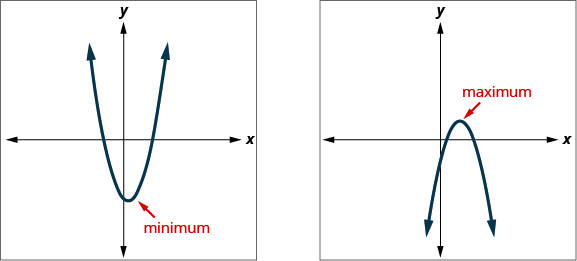
Minimum or Maximum Values of a Quadratic Equation
The y-coordinate of the vertex of the graph of a quadratic equation is the
- minimum value of the quadratic equation if the parabola opens upward.
- maximum value of the quadratic equation if the parabola opens down.
Find the minimum value of the quadratic equation ![]() .
.
Find the maximum or minimum value of the quadratic equation ![]() .
.
The minimum value is ![]() when
when ![]() .
.
Find the maximum or minimum value of the quadratic equation ![]() .
.
The maximum value is 5 when ![]() .
.
We have used the formula
![]()
to calculate the height in feet, ![]() , of an object shot up into the air with initial velocity,
, of an object shot up into the air with initial velocity, ![]() , after
, after ![]() seconds.
seconds.
This formula is a quadratic equation in the variable ![]() , so its graph is a parabola. By solving for the coordinates of the vertex, we can find how long information technology will take the object to achieve its maximum height. And then, we tin calculate the maximum height.
, so its graph is a parabola. By solving for the coordinates of the vertex, we can find how long information technology will take the object to achieve its maximum height. And then, we tin calculate the maximum height.
The quadratic equation ![]() models the height of a volleyball hit straight upwardly with velocity 176 feet per second from a height of 4 anxiety.
models the height of a volleyball hit straight upwardly with velocity 176 feet per second from a height of 4 anxiety.
- ⓐ How many seconds will it take the volleyball to reach its maximum meridian?
- ⓑ Find the maximum pinnacle of the volleyball.
Solution
![]()
Since a is negative, the parabola opens downwards.
The quadratic equation has a maximum.
- ⓐ

- ⓑ
Notice h when  .
.

Utilize a estimator to simplify. 
The vertex is  .
.Since the parabola has a maximum, the h-coordinate of the vertex is the maximum y-value of the quadratic equation. The maximum value of the quadratic is 488 anxiety and information technology occurs when  seconds.
seconds.
The quadratic equation ![]() is used to find the height of a rock thrown upward from a summit of 32 feet at a rate of 128 ft/sec. How long will information technology take for the stone to reach its maximum height? What is the maximum height? Round answers to the nearest tenth.
is used to find the height of a rock thrown upward from a summit of 32 feet at a rate of 128 ft/sec. How long will information technology take for the stone to reach its maximum height? What is the maximum height? Round answers to the nearest tenth.
It will take 4 seconds to achieve the maximum acme of 288 feet.
A toy rocket shot upward from the footing at a rate of 208 ft/sec has the quadratic equation of ![]() . When will the rocket reach its maximum superlative? What will be the maximum height? Round answers to the nearest tenth.
. When will the rocket reach its maximum superlative? What will be the maximum height? Round answers to the nearest tenth.
It will take 6.5 seconds to reach the maximum summit of 676 feet.
Cardinal Concepts
Section Exercises
Practise Makes Perfect
Recognize the Graph of a Quadratic Equation in 2 Variables
In the following exercises, graph:
![]()
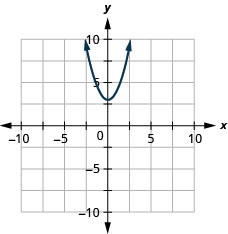
![]()
In the following exercises, determine if the parabola opens up or down.
![]()
downward
![]()
![]()
up
![]()
Find the Axis of Symmetry and Vertex of a Parabola
In the following exercises, notice ⓐ the axis of symmetry and ⓑ the vertex.
![]()
![]()
Find the Intercepts of a Parabola
In the post-obit exercises, find the x– and y-intercepts.
![]()
![]()
![]()
![]()
![]()
![]()
![]()
![]()
![]()
Graph Quadratic Equations in Two Variables
In the post-obit exercises, graph by using intercepts, the vertex, and the axis of symmetry.
![]()
![]()
![]()
![]()
![]()
![]()
![]()
![]()
![]()
![]()
![]()
![]()
![]()
![]()
![]()
![]()
![]()
![]()
Solve Maximum and Minimum Applications
In the following exercises, find the maximum or minimum value.
![]()
The minimum value is ![]() when
when ![]() .
.
![]()
![]()
The minimum value is 6 when ![]() .
.
![]()
![]()
The maximum value is 16 when ![]() .
.
![]()
In the following exercises, solve. Circular answers to the nearest tenth.
An arrow is shot vertically upward from a platform 45 feet high at a rate of 168 ft/sec. Use the quadratic equation ![]() to discover how long information technology will take the arrow to reach its maximum height, and then find the maximum height.
to discover how long information technology will take the arrow to reach its maximum height, and then find the maximum height.
In five.three sec the arrow will reach maximum height of 486 ft.
A stone is thrown vertically upward from a platform that is xx feet loftier at a charge per unit of 160 ft/sec. Use the quadratic equation ![]() to find how long it will have the stone to reach its maximum height, and then observe the maximum height.
to find how long it will have the stone to reach its maximum height, and then observe the maximum height.
A rancher is going to fence three sides of a corral side by side to a river. He needs to maximize the corral area using 240 feet of fencing. The quadratic equation ![]() gives the area of the corral,
gives the area of the corral, ![]() , for the length,
, for the length, ![]() , of the corral forth the river. Find the length of the corral forth the river that will requite the maximum area, and then observe the maximum area of the corral.
, of the corral forth the river. Find the length of the corral forth the river that will requite the maximum area, and then observe the maximum area of the corral.
The length of the side forth the river of the corral is 120 feet and the maximum area is seven,200 sq ft.
Everyday Math
Writing Exercises
For the revenue model in (Figure) and (Figure), explain what the ten-intercepts mean to the figurer store owner.
Answers volition vary.
For the revenue model in (Figure) and (Figure), explain what the 10-intercepts hateful to the backpack retailer.
Self Check
ⓐ Subsequently completing the exercises, use this checklist to evaluate your mastery of the objectives of this section.

ⓑ What does this checklist tell you lot almost your mastery of this department? What steps will you take to better?
Chapter 10 Review Exercises
10.3 Solve Quadratic Equations Using the Quadratic Formula
In the post-obit exercises, solve past using the Quadratic Formula.
![]()
![]()
![]()
![]()
![]()
![]()
![]()
![]()
![]()
![]()
![]()
![]()
![]()
no real solution
![]()
![]()
![]()
![]()
![]()
![]()
![]()
![]()
![]()
![]()
In the following exercises, determine the number of solutions to each quadratic equation.
In the following exercises, identify the most appropriate method (Factoring, Square Root, or Quadratic Formula) to use to solve each quadratic equation.
ⓐ gene ⓑ Quadratic Formula ⓒ foursquare root
10.4 Solve Applications Modeled past Quadratic Equations
In the post-obit exercises, solve by using methods of factoring, the square root principle, or the quadratic formula.
Find two sequent odd numbers whose production is 323.
2 sequent odd numbers whose product is 323 are 17 and 19, and ![]() and
and ![]()
Discover two sequent even numbers whose production is 624.
A triangular banner has an expanse of 351 square centimeters. The length of the base is two centimeters longer than iv times the meridian. Observe the summit and length of the base.
The peak of the banner is thirteen cm and the length of the side is 54 cm.
Julius built a triangular brandish case for his coin drove. The height of the display case is six inches less than twice the width of the base of operations. The area of the of the back of the case is 70 square inches. Discover the peak and width of the case.
A tile mosaic in the shape of a right triangle is used as the corner of a rectangular pathway. The hypotenuse of the mosaic is v feet. 1 side of the mosaic is twice every bit long as the other side. What are the lengths of the sides? Round to the nearest tenth.

The lengths of the sides of the mosaic are 2.ii and four.4 feet.
A rectangular piece of plywood has a diagonal which measures ii feet more than than the width. The length of the plywood is twice the width. What is the length of the plywood's diagonal? Round to the nearest tenth.
The front walk from the street to Pam's house has an area of 250 square feet. Its length is two less than iv times its width. Notice the length and width of the sidewalk. Circular to the nearest tenth.
The width of the forepart walk is 8.1 feet and its length is 30.8 feet.
For Sophia's graduation political party, several tables of the aforementioned width volition be bundled end to end to requite a serving table with a total area of 75 square feet. The total length of the tables volition be two more than three times the width. Find the length and width of the serving tabular array and so Sophia can buy the correct size tablecloth. Round answer to the nearest tenth.

A ball is thrown vertically in the air with a velocity of 160 ft/sec. Use the formula ![]() to determine when the brawl volition be 384 feet from the ground. Round to the nearest tenth.
to determine when the brawl volition be 384 feet from the ground. Round to the nearest tenth.
The ball will reach 384 anxiety on its style upward in 4 seconds and on the fashion downwards in 6 seconds.
A bullet is fired straight upward from the ground at a velocity of 320 ft/sec. Utilize the formula ![]() to determine when the bullet volition reach 800 feet. Round to the nearest tenth.
to determine when the bullet volition reach 800 feet. Round to the nearest tenth.
x.v Graphing Quadratic Equations in Two Variables
In the following exercises, graph past plotting point.
Graph ![]()
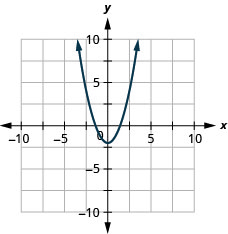
Graph ![]()
In the following exercises, make up one's mind if the post-obit parabolas open or down.
![]()
downward
![]()
![]()
up
![]()
In the following exercises, find ⓐ the axis of symmetry and ⓑ the vertex.
![]()
In the post-obit exercises, observe the x– and y-intercepts.
![]()
![]()
![]()
![]()
![]()
![]()
![]()
![]()
![]()
In the following exercises, graph by using intercepts, the vertex, and the axis of symmetry.
![]()
![]()
![]()
![]()
![]()
![]()
![]()
![]()
In the following exercises, observe the minimum or maximum value.
![]()
The minimum value is ![]() when
when ![]() .
.
![]()
In the following exercises, solve. Rounding answers to the nearest tenth.
A ball is thrown upward from the ground with an initial velocity of 112 ft/sec. Utilise the quadratic equation ![]() to find how long it will accept the brawl to accomplish maximum superlative, and then find the maximum superlative.
to find how long it will accept the brawl to accomplish maximum superlative, and then find the maximum superlative.
In iii.5 seconds the ball is at its maximum top of 196 feet.
Practice Test
Use the Foursquare Root Property to solve the quadratic equation: ![]() .
.
![]()
Utilise Completing the Square to solve the quadratic equation: ![]() .
.
Use the Quadratic Formula to solve the quadratic equation: ![]() .
.
![]()
Solve the post-obit quadratic equations. Use any method.
![]()
![]()
![]()
![]()
![]()
no real solution
![]()
Utilise the discriminant to determine the number of solutions of each quadratic equation.
![]()
2
![]()
Solve by factoring, the Square Root Holding, or the Quadratic Formula.
Find 2 consecutive even numbers whose product is 360.
Ii consecutive even number are ![]() and
and ![]() and 18 and twenty.
and 18 and twenty.
The length of a diagonal of a rectangle is three more than than the width. The length of the rectangle is three times the width. Detect the length of the diagonal. (Round to the nearest tenth.)
For each parabola, find ⓐ which ways it opens, ⓑ the axis of symmetry, ⓒ the vertex, ⓓ the x– and y-intercepts, and ⓔ the maximum or minimum value.
![]()
![]()
Graph the following parabolas by using intercepts, the vertex, and the centrality of symmetry.
![]()
![]()
Solve.
A water balloon is launched upward at the charge per unit of 86 ft/sec. Using the formula ![]() , find how long it volition accept the balloon to attain the maximum height and then notice the maximum height. Round to the nearest 10th.
, find how long it volition accept the balloon to attain the maximum height and then notice the maximum height. Round to the nearest 10th.
Source: https://opentextbc.ca/elementaryalgebraopenstax/chapter/graphing-quadratic-equations/
Posted by: gagnefloore45.blogspot.com


0 Response to "How To Find The Solution Of A Quadratic Equation"
Post a Comment